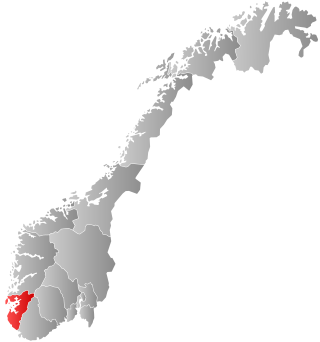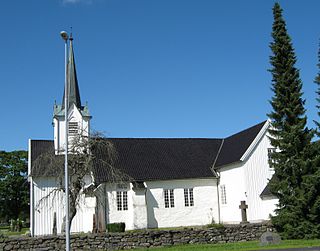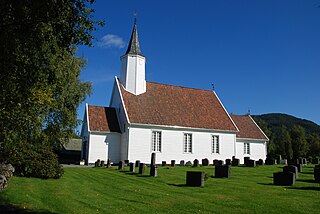
Sokndal is the southernmost municipality in Rogaland county, Norway. It is located in the traditional district of Dalane. The administrative centre of the municipality is the village of Hauge. Other villages in Sokndal include Li, Rekefjord, Sogndalsstranda, and Åna-Sira.

Lund is a municipality in Rogaland county, Norway. It is located in the traditional district of Dalane. The administrative centre of the municipality is the village of Moi. Other villages in Lund include Eik and, Heskestad. European route E39 and the Sørlandet Line both pass through Lund. Moi Station is a railway station in Lund.

Kopervik is the largest town on the island of Karmøy in Rogaland county, Norway. It is also the administrative centre of the municipality of Karmøy. It is part of the traditional district of Haugaland. The town was also an independent municipality from 1866 until 1965.

is a town in Karmøy municipality in Rogaland county, Norway. It is located on the southernmost tip of the island of Karmøy at the entrance to the Boknafjorden and Karmsundet strait. The town is part of the traditional district of Haugaland. The town was an independent municipality due to its status as a ladested from 1858 until 1965.

Skudenes is a former municipality in Rogaland county, Norway. It was part of the traditional district of Haugaland. The 68-square-kilometre (26 sq mi) municipality existed from 1838 until its dissolution in 1965. The administrative centre was the town of Skudeneshavn. The municipality originally encompassed land that is now part of the municipalities of Bokn and Karmøy. It included the southern part of the island of Karmøy and the three islands to the east: Vestre Bokn, Austre Bokn, and Ognøya. In 1849, the three smaller islands were separated to form Bokn municipality.

Vestre Moland is a former municipality in the old Aust-Agder county in Norway. The administrative centre of the municipality was the village of Møglestu where the Vestre Moland Church is located. The 103-square-kilometre (40 sq mi) municipality existed from 1838 until 1962 when it was merged into the municipality of Lillesand. Today, the area of Vestre Moland covers the northern part of the present-day municipality of Lillesand in Agder county.

Årdal is a former municipality in Rogaland county, Norway. The 558-square-kilometre (215 sq mi) municipality existed from 1859 until 1965. It stretched from the head of the Årdalsfjorden in the west to the county border in the east. It encompassed the southern half of the present-day Hjelmeland Municipality. The administrative centre of the municipality was the village of Årdal where the Old Årdal Church is located.

Stangaland is a former municipality in Rogaland county, Norway. It was part of the traditional district of Haugaland. The municipality of Stangaland existed from 1909 until 1965 when it was merged into the newly created Karmøy Municipality. The 28-square-kilometre (11 sq mi) municipality encompassed the rural areas surrounding the coastal city of Kopervik on the island of Karmøy. The administrative centre was the village of Stangaland just outside the town of Kopervik.

Torvastad is a former municipality in Rogaland county, Norway. The municipality existed from 1838 until 1965. The administrative centre was the village of Haugesund, and after that it was the village of Torvastad on the island of Karmøy. Today, the area of Torvastad refers to the northern part of the municipality of Karmøy.

Høyland is a former municipality in Rogaland county, Norway. The 170-square-kilometre (66 sq mi) municipality was located at the innermost end of the Gandsfjorden in the western part of the present-day municipality of Sandnes. The municipality existed from 1838 until its dissolution in 1965. The main church for the municipality was Høyland Church.

Åkra is a former municipality in the traditional district of Haugaland in Rogaland county, Norway. The 33-square-kilometre (13 sq mi) municipality existed from 1892 until 1965 and it encompassed the central part of the western coast of the island of Karmøy. The administrative centre was the village of Åkrehamn.

Rekefjord is a harbour village in the municipality of Sokndal in Rogaland county, Norway. The village is located around the Rekefjorden, about 1 kilometre (0.62 mi) west of the municipal centre of Hauge i Dalane. The village of Sogndalsstranda lies about 2 kilometres (1.2 mi) southeast of Rekefjord.

Jelsa is a former municipality in Rogaland county, Norway. The 130-square-kilometre (50 sq mi) municipality existed from 1838 until 1965. It encompassed area that surrounds the Sandsfjorden in the present-day municipalities of Suldal, Hjelmeland, and Stavanger. The administrative centre was the village of Jelsa, where Jelsa Church is located.

Sand is a former municipality in Rogaland county, Norway. The 221-square-kilometre (85 sq mi) municipality encompassed the area around the Hylsfjorden and the inner part of the Sandsfjorden in the present-day Suldal Municipality. The administrative centre of the municipality was the village of Sand where Sand Church is located.

Vikedal is a former municipality in Rogaland county, Norway. The 134-square-kilometre (52 sq mi) municipality existed from 1838 until its dissolution in 1965. It was located along the Vindafjorden and Sandeidfjorden in the northern part of the Ryfylke district. The administrative centre of the municipality was the village of Vikedal, where Vikedal Church is located.

Skjold is a former municipality in Rogaland county, Norway. The 172-square-kilometre (66 sq mi) municipality encompassed all the area surrounding the Grindafjorden and Skjoldafjorden. The area is located in the present-day municipalities of Vindafjord and Tysvær. The administrative centre of the municipality was the village of Skjold where the Skjold Church is located.

Nedstrand is a former municipality in Rogaland county, Norway. The 119-square-kilometre (46 sq mi) municipality was located along the Nedstrandfjorden, an inner branch off the main Boknafjorden. The municipality encompassed the majority of the Nedstrand peninsula. Originally it also included the Sjernarøyane islands and the western part of the island of Ombo in the fjord to the south. The administrative centre of the municipality was the village of Nedstrand. Nedstrand Church is located in Hindaråvåg, a small village just west of Nedstrand village. Today, the area is part of the large municipality of Tysvær.

Madla is a former municipality in Rogaland county, Norway. The 15.75-square-kilometre (6.08 sq mi) municipality existed from 1930 until 1965 when it was merged into Stavanger Municipality. The small municipality now exists as the borough of Madla inside the city of Stavanger, on the northeast side of the Hafrsfjorden. It was one of the smallest municipalities in Rogaland county, with only four farms: Malde, Revheim, and North- and South-Sunde. The municipal centre was located at Malde, now known as Madlamark.

Helleland is a former municipality in Rogaland county, Norway. The 148-square-kilometre (57 sq mi) municipality existed from 1838 until its dissolution in 1965. The municipality is now located in the central part of the present-day municipality of Eigersund. The administrative centre of the municipality was the village of Helleland where the Helleland Church is located.

Vemundvik is a former municipality in the old Nord-Trøndelag county, Norway. The 247-square-kilometre (95 sq mi) municipality existed from 1838 until its dissolution in 1964. By 1964, the municipality roughly corresponded to the mainland areas north of the river Namsen in what is now the municipality of Namsos in Trøndelag county. From 1838 until about 1942, the administrative centre was the village of Vemundvik where Vemundvik Church is located. After 1941, the municipal offices and administration was headquartered in the town of Namsos.


















